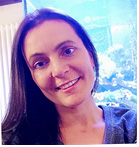 Researcher
Researcher
Biology and Evolution of Marine Organisms Department
Tel.: +39 081 5833322
e-mail: eva.terzibasi(at)szn.it
Contatto Skype: eva terzibasi tozzini
Google scholar: https://scholar.google.com/citations?user=cpkslV4AAAAJ&hl=en
ERC sectors - Physiology in health, disease and ageing (LS4), Neuroscience and disorders of the nervous system (LS5)
Settori scientifico-disciplinari - Anatomia comparata e citologia (BIO/06), Fisiologia (BIO/09)
Lab Members
Chiavacci Elena
Research Interests
I graduated in Marine Biology and specialized during my PhD and postdoc in the neurobiology of a short-lived aquatic vertebrate model, focusing my studies on aging, neurodegeneration, adult neurogenesis and circadian rhythms. The neural adaptation of marine vertebrates to different environments and environmental changes is a topic that has been poorly investigated until now. My research interest focuses on the study of the neurobiology of marine organisms in an evolutionary and eco-physiological perspective, and in particular on:
1. Comparative studies on the organization of the CNS in different species of basal marine vertebrates in the phylogenetic tree of chordates, with particular attention to neuroanatomy and distribution of neurogenic niches
2. Study of the evolution of neurotrophins: after a first whole genome duplication in cyclostomes, a second duplication event occurred in chondrichthyans during the evolution, suggesting the appearance of four different neurotrophins and related receptors in this aquatic basal group. The comparative analysis of neurotrophins expression in the lamprey (Petromizon marinus) and different species of chondrichthyans (in particular, Scyliorhinus canicula) will add new advances applicable to conventional and unconventional model systems, contributing significantly to the neurobiology of marine vertebrates
3. Study of aging and age-related processes in cartilaginous fish: the Greenland shark Somniosus microcephalus, is the longest lived vertebrate, with a life expectancy of over 270 years, based on radiocarbon dating in the cornea. The idea is to carry out a comparative study between S. microcephalus and other sister species (such as the mediterranean S. rostratus), to analyze the evolution of the variation of life history traits in vertebrates under genetic and neuro-anatomical aspect.
Due to the important functional role of the nervous system in an organism's adaptive response to its specific environment, a deeper understanding of active neural processes, such as adult neurogenesis and neurodegeneration, could be a key factor in more effective monitoring of thehealt of the organisms and the general equilibrium of the ecosystem itself.
Selected Publications
Louka, A., Bagnoli, S., Rupert, J., Esapa, B., Tartaglia, G.G., Cellerino, A., Pastore, A., & Terzibasi Tozzini, E. (2022). New lessons on TDP‐43 from old N. furzeri killifish. Aging Cell, 21(1), e13517.
Bagnoli, S., & Terzibasi Tozzini, E. (2021). Age-dependent regulation of notch family members in the neuronal stem cell niches of the short-lived killifish Nothobranchius furzeri. Frontiers in Cell and Developmental Biology, 9, 640958.
Terzibasi Tozzini, E., Dorn, A., Ng’oma, E., Polačik, M., Blažek, R., Reichwald, K., Petzold, A., Watters, B., Reichard, M., & Cellerino, A. (2013). Parallel evolution of senescence in annual fishes in response to extrinsic mortality. BMC Evolutionary Biology, 13, 1-12.
Tozzini, E.T., Baumgart, M., Battistoni, G., & Cellerino, A. (2012). Adult neurogenesis in the short‐lived teleost Nothobranchius furzeri: localization of neurogenic niches, molecular characterization and effects of aging. Aging Cell, 11(2), 241-251.
Terzibasi, E., Lefrançois, C., Domenici, P., Hartmann, N., Graf, M., & Cellerino, A. (2009). Effects of dietary restriction on mortality and age‐related phenotypes in the short‐lived fish Nothobranchius furzeri. Aging Cell, 8(2), 88-99.










